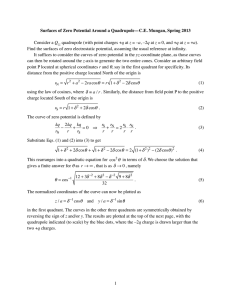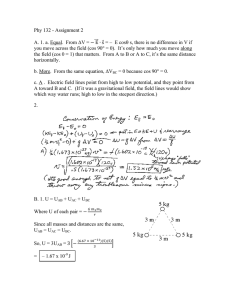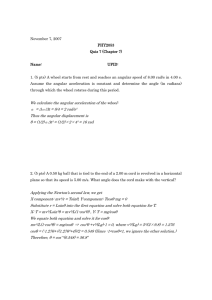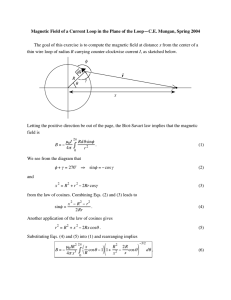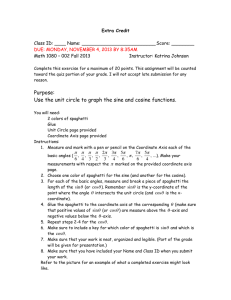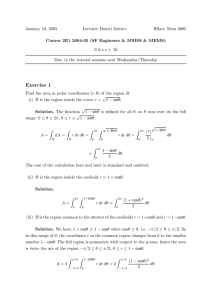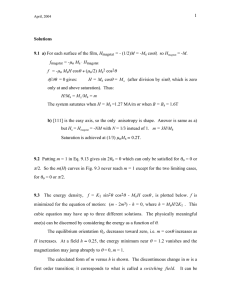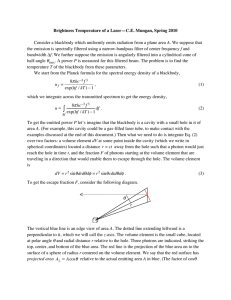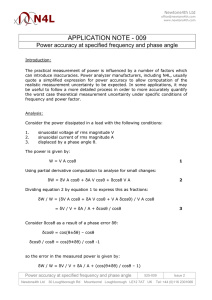11. Laplace tidal equations on the sphere linearized
advertisement
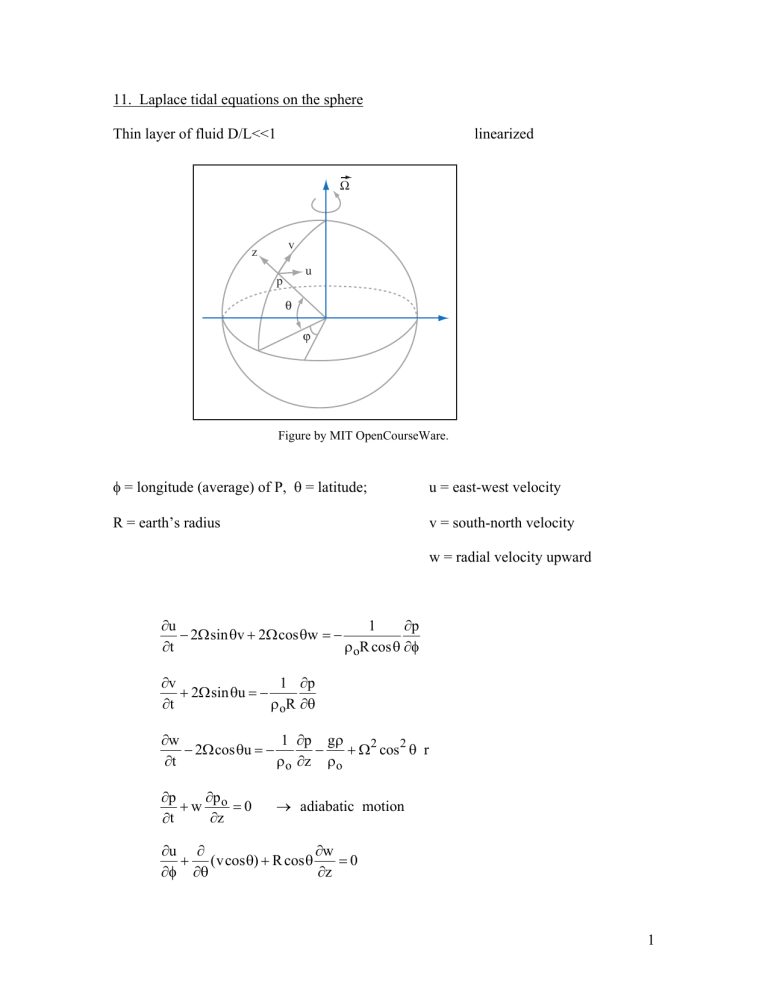
11. Laplace tidal equations on the sphere Thin layer of fluid D/L<<1 linearized Ω v z u p θ ϕ Figure by MIT OpenCourseWare. φ = longitude (average) of P, θ = latitude; u = east-west velocity R = earth’s radius v = south-north velocity w = radial velocity upward 1 ∂u ∂p − 2Ωsinθv + 2Ωcosθw = − ρ oR cosθ ∂φ ∂t 1 ∂p ∂v + 2Ωsinθu = − ρ oR ∂θ ∂t 1 ∂p gρ ∂w − 2Ωcosθu = − − + Ω2 cos 2 θ r ρ o ∂z ρ o ∂t ∂p ∂p +w o =0 ∂z ∂t → adiabatic motion ∂u ∂ ∂w + (vcosθ) + R cosθ =0 ∂φ ∂θ ∂z 1 The equations have been linearized and, as usual, we have split ρtotal = ρo(z) + ρ(φ,θ,z,t) with ρtotal = po(z) + p(φ,θ,z,t) dρ o = −ρ og dz The third momentum equation contains the centrifugal force which can be written as the gradient of the centrifugal potential 1 ∇( Ω 2 cos 2 θ r 2 ) 2 r = distance from center of the earth ∂ ∂ = ∂r ∂z which can be combined with the gravitational potential: 1 ∇(gr + Ω2 cos2 θ r 2 ) = ∇g' → ellipsoidal sufaces 2 g’ varies by about 0.3% from the pole to the equator. In this way we can eliminate the centrifugal component which is very small and we keep spherical coordinates because the variation in g’ is very small. More important are the two components of the Earth’s rotation, 2Ω cosθ, tangent to the earth’s surface. In the first momentum equation W D = << 1 U L from continuity Thus, on the basis of scale analysis we can ignore the tangent component of the Earth’s rotation in the first momentum equation. 2 Then energy arguments make it necessary to ignore the tangent component also in the third momentum equation. In fact if we keep it and we form the energy equation, we find the Coriolis force doing work, which is impossible. Neglecting 2Ωcosθ w and 2Ωcosθ u is often called the traditional approximation. We want, however to justify it again through scale analysis. The scale for the pressure field is determined by the geostrophic balance (second momentum eq. as the 2 terms are both 0(1). P* = ρo2UL then ∂P * ΩUL = 0(ρ o 2 ) ∂z D Then in the third momentum equation: ρ o 2Ωucosθ D = 0( ) << 1 Pz L And we can ignore the tangent component of the Earth’s rotation also in the third momentum, eq. Then u t − 2Ωsinθv = − 1 pφ ρ oR cosθ v t + 2Ωsinθu = − 1 pθ ρ oR 0 = -pz – gρ -> hydrostatic uφ + (vcosθ)θ + Rcosθ wz = 0 ρt + w dρ o =0 dz 3 Where in the third momentum equation we have neglected the vertical acceleration as for large scale motions |wt|<<g. As already done, we can write the adiabatic equation as ρ oN 2 ρt − w =0 g with N 2 = −g dρ o ρ o dz gρ = -pz combining the two we eliminate ρ gρt = wρoN2 = -pzt pzt + ρoN2 w = 0 knowing pz, we know ρ So now we have 4 equations in (u,v,w, p) u t − 2Ωsinθv = − 1 Pφ ρ oR cosθ v t + 2Ωsinθu = − 1 Pφ ρ oR uφ + (vcosθ)θ + Rcosθ wz = 0 pzt + ρoN2w = 0 We consider a flat bottom only z = -D, because in this case we can make a separation of variables into a function of z and one of (φ , θ): ⎛ ⎞ ⎡U(φ,θ,t)⎤ ⎜ u⎟ = ⎢ F(z) ⎝ v⎠ ⎣V(φ,θ,t)⎥⎦ same vertical dependence for (u,v) as they w = W(φ,θ,t) G(z) have similar structure P = gP(φ,θ,t)F(z) ρo --> needed from geostrophic balance (U is not a velocity scale now, is a variable!) Substituting into the z horizontal momentum eqn., F(z) drops out: 4 Vt – fV = − g Pφ Re nθ f = 2Ωsinθ g Vt + fV = − Pθ R The continuity eq. is more complicated ⎡ Uφ (V cos)θ ⎤ + ⎢ ⎥F(z) + WG z = 0 ⎣R cosθ R cosθ ⎦ or (V G 1 ) ⎤ 1 ⎡ Uφ + cos θ θ ⎥ = − z = − ⎢ R cosθ ⎦ F h W ⎣R cosθ independent of z separations constant dependent only on z 1 dG 1 = dimensions of depth = F dz h called “equivalent depth” Then the horizontal structure equation for continuity is: Uφ R cosθ + (V cosθ)φ R cosθ + W =0 h The adiabatic equation with the separation of variables becomes gPt Fz (z) + N 2WG(z) = 0 or Pt + W N2 G =0 g Fz But from F Gz 1 = → G zz = z ⇒ Fz = hb zz h F h and we have 5 Pt + W G N2 =0 G zz gh or Pt W = − G N2 G zz gh = arbitrary constant Notice that while before the separation constant h had the dimensions of a depth now G ⎛ g dρ o ⎞ 1 2 1 ⎜− ⎟ = 0(λ • 2 ) = dimensionless G zz ⎝ ρ o dz ⎠ gh λ The separation constant is dimensionless and can be arbitrarily chosen. Choose Pt =1 W → Pt = W adiabatic equation the G N2 − =1 G zz gh → N2 G zz + G=0 gh Rewrite all equations: 1. U t − fV = − 2. Vt + fU = − 3. Uφ R cosθ + g Pφ R cosθ g Pθ R (V cosθ)θ W + =0 R cosθ h Laplace’s tidal equations: The equations for the horizontal structure 4. Pt = W 5. G zz + N2 G=0 gh F = hG z 6 Notice that the vertical dependence is contained only in the last equation which with the appropriate boundary conditions is an eigenvalue problem in which h−1 n is the eigenvalue. Now we need to specify the boundary condition. At z = -D w = 0 => G(z) ≡ 0 At the free surface η the kinematic condition w = Ptotal = patm ≡ 0 ∂η gives WG(η) = ∂η /∂t ∂t ptotal = po(z) + p at z = η p total p o (η) = + gPF(η) expand around z = o ρo ρo p (o) 1 dp o |z=o η + ...gPF(o) = 0 ≈ o + ρ o dz ρo gPF(0) = gη ∂ : ∂t g ∂η = gPt F(0) ∂t or gWG(0) = gPtF(0) at z = 0 But from 4, adiabatic equation, Pt = W Therefore, G(0) = F(0) = hGz(0) or Gz − g =0 h at from F = hGz z=o So, finally, the eigenvalue problem for G is G zz + N2 G=0 gh Vertical structure equation G = 0 at z = -D Gz − G =0 h at z = 0 7 Notice that there is an infinite number of horizontal structure equations, each set being identical except that instead of the total water depth -D, each system has an equivalent depth hn corresponding to the n-eigenvalue of the problem. Generally, the problem must be solved numerically. Let us examine the simplest case N2 = constant. Notice that, if we had kept ∂w in the third momentum eq. and assumed a ∂t time-dependent e-ιωt for all the functions, we would have obtained the following eigenvalue problem: G zz + N2 − ω2 G=o gh G = o at z = -D 1 Gz − G = o h at z=o For N2 = constant a solution G(z) satisfying the bottom boundary condition at z = -D is G = A sin[m(z+D)] m2 = N2 gh the wavenumber, quantized The eigenvalue relation for h is obtained from the surface boundary condition and gives N2 tan(mD) = mh = gm Infinite number of denumerable solutions 8 RHS m RHS Figure by MIT OpenCourseWare. Write the dispersion relationships as: ⎛ N 2D ⎞ 1 ⎟⎟ tan(mD) = ⎜⎜ ⎝ g ⎠ mD Notice that ⎡N 2D ⎤ D dρo Δρo ⎢ ~ << 1⎥ =− ρ o dz ρ o ⎢⎣ g ⎦ Then we can consider 2 limits mD = 0(1) or large m. Then RHS of above ≈ 0 (<<1) and the solutions are tan(mD) = 0 mD = nπ As m2 = n = 1,2,3 and m = nπ D N2 the equivalent depth for mode n is gh N 2D gh n = 2 2 n π For this mode the horizontal equations will have a long wave-gravity wave speed c n = gh n << gD These speeds are the long wave speeds for internal gravity modes, much slower than the phase speed gD . 9 The model structures for each n are simply ⎡nπ(z + D) ⎤ Gn = sin ⎢ ⎥⎦ D ⎣ ⎡nπ(z + D) ⎤ Fn =cos ⎢ ⎥⎦ D ⎣ Baroclinic modes Lowest mode Suppose now that mD->o, very small m, very large λz. Then tan(mD)≈mD = But m2 = N2 gm -> N2 -> ho = D gh m2 = N2 gD total depth This is the lowest mode, the barotropic one Then mo = N2 gD mo -> o Fo =cos[mo(z+D)] is almost z-independent Because of the possibility of variable separation, we can simply study the wave solutions of the horizontal structure equations, remembering that for each solution there is a vertical structure function associated. Combining 3 and 4, we can finally write the Laplace tidal equations as Ut –fV = − g Pφ R cosθ Vt + fU = − g Pθ R I ⎡ Vφ (V cosθ)θ ⎤ + =0 Pt + h⎢ R cosθ ⎥⎦ ⎣ R cosθ 10 MIT OpenCourseWare http://ocw.mit.edu 12.802 Wave Motion in the Ocean and the Atmosphere Spring 2008 For information about citing these materials or our Terms of Use, visit: http://ocw.mit.edu/terms.
